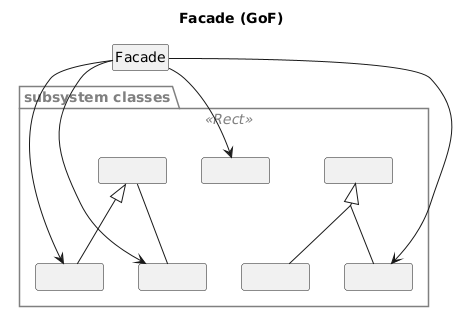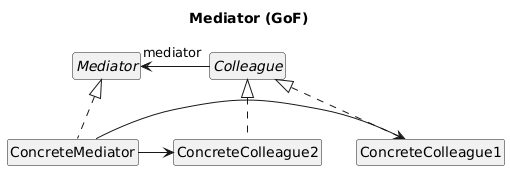Difference between Facade and Mediator Design pattern?
What is the difference between facade and mediator design pattern. I want understand which design pattern to choose between these two in which scenario. I was going through the following links and found both same in terms of use case.
Facade design pattern : http://www.tutorialspoint.com/design_pattern/facade_pattern.htm
Mediator design pattern : http://www.java2s.com/Tutorial/Java/0460__Design-Pattern/CoordinatingYourObjectswiththeMediatorPatterns.htm
I have confusion in following code segment which looks similar in both the design patterns.
Facade class:
public class ShapeMaker {
private Shape circle;
private Shape rectangle;
private Shape square;
public ShapeMaker() {
circle = new Circle();
rectangle = new Rectangle();
square = new Square();
}
public void drawCircle(){
circle.draw();
}
public void drawRectangle(){
rectangle.draw();
}
public void drawSquare(){
square.draw();
}
}
Mediator class :
public class Mediator {
Welcome welcome;
Browse browse;
Purchase purchase;
Exit exit;
public Mediator() {
welcome = new Welcome(this);
browse = new Browse(this);
purchase = new Purchase(this);
exit = new Exit(this);
}
public void handle(String state) {
if (state.equals("welcome.shop")) {
browse.execute();
} else if (state.equals("shop.purchase")) {
purchase.execute();
} else if (state.equals("purchase.exit")) {
exit.execute();
}
I have confusion in following code segment which looks similar in both the design patterns.
I think you're seeing the composition aspects of both patterns.
Facade links to various existing classes of a subsystem to add some typical functionality that simplifies use of the subsystem. In the example code you cited, ShapeMaker provides services that facilitate making shapes.
Mediator links to various colleagues that have to collaborate, so as to minimize the knowledge the colleagues have about each other. Minimizing knowledge has the side effect of reducing coupling between colleagues (they only know the mediator) and increasing their cohesion (they generally have less to worry about since they don't know about the bigger picture).
In both patterns, the centralized class assumes responsibility for the complexity of dealing with the classes it is linked to.
Here are the basic patterns in UML from the Gang of Four:
- How to convert two longs to a byte array = how to convert UUID to byte array?
- Deserializing JSON array with JSON-B
- Generate GCP auth identity-token in JAVA
- Get exact file size via smbj
- Disable HTML Warnings in Eclipse for Java EE developers edition
- Image between fragments in a viewpager while swapping
- Linear search in a sorted array - Java
- Create threads in java to run in background
- Spring Boot adds 'es' to the links
- Why is the wallet address generated by ton4j library using 24 words different from the real address of the wallet created using ton blockchain apps?
- Impact of high CPU usage on a background thread execution in Java
- Map implementation with duplicate keys
- Java can't find symbol
- Java application not recording from microphone when packaged using install4j
- Using kafka-schema-registry-maven-plugin with parent and child schemas
- How to add a "driver" to javax.comm? Serial port programming in Java
- Java 6: Unsupported @SuppressWarnings("rawtypes") warning
- java.lang.ClassCastException: java.util.LinkedHashMap cannot be cast to com.testing.models.Account
- Connecting 2 java files in visual studio
- Unnecessary warnings for Freemarker classes on native image execution
- How do I increase the default timeout in the Cassandra Java driver using the DriverConfigLoader?
- NetBeans IDE Java 1.4 compatibility: compiler not warning on JDK 5+ classes/methods
- what is the need for importing libraries multiple times
- Converting number to word
- Spring Boot - Return an empty array of objects
- Do we have XSDs particularly for Spring 5.x?
- Spring + Ehcache : How to cache find all result
- Java 17+ Native-Image Logback
- java -jar x.jar in Windows PowerShell, non-ASCII characters cannot be displayed well
- Kafka Best Practices + how to set recommended setting for JVM

